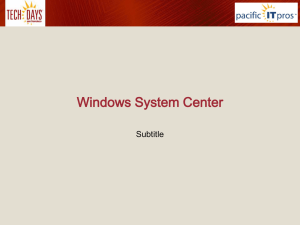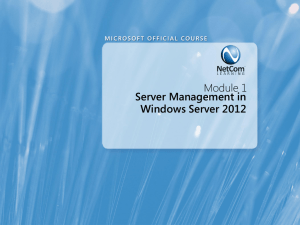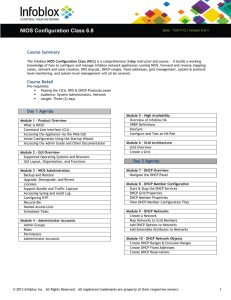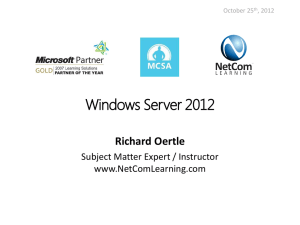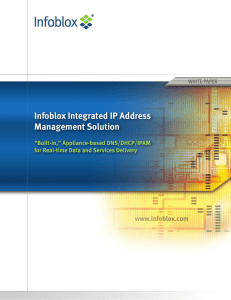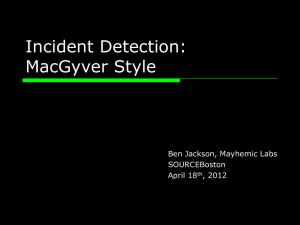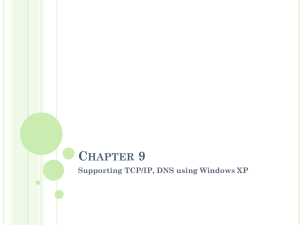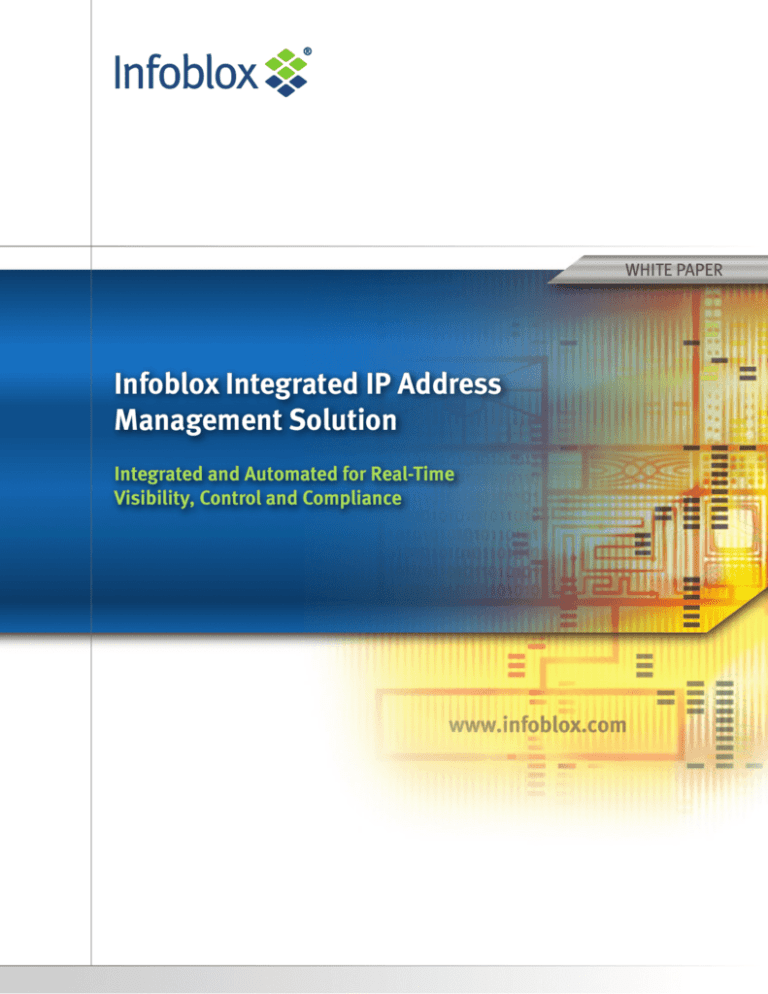
WHITE PAPER
Infoblox Integrated IP Address
Management Solution
Integrated and Automated for Real-Time
Visibility, Control and Compliance
Integrated IP Address Management Solution
WHITE PAPER
An Introduction to IP Address Management
IP address management (IPAM) refers to the management of allocation, administration, reporting and tracking of public and private IP
space, IP devices and associated data. Enterprises typically deploy
systems and processes that interact with the DNS and DHCP infrastructure in order to provide IPAM capabilities.
A majority of IT departments use manual processes, spreadsheets or home-grown tools for IP address management. A
typical process for a new IP address assignment to a printer may
involve several steps spanning several departments; as a result,
a simple request for an IP address for a new device may require
hours of work and days of elapsed time as each set of hands
becomes involved in the process, with the attendant potential
for introducing errors along the way.
Fig 1: IPAM Lifecycle
The Infoblox IP address management solution automates and simplifies IP address management thus reducing
network operating costs and eliminating configuration errors and associated downtime.
This whitepaper discusses the importance of a sophisticated IPAM solution and provides an overview of how
Infoblox IPAM solution satisfies all of the key IPAM requirements for today’s organizations.
Why Is IP Address Management Important?
The criticality of TCP/IP networks continues to increase over time. The growth in virtualization, cloud and mobile
computing and the introduction of diverse IP-based devices such as IP telephones, cameras, and RFID readers
means that soon virtually every business activity—from gaining access to a building to making a phone call—will
be mediated by the IP network. As the networks become more dynamic, the complexity of networks increases and
IP address management becomes challenging. Using manual processes and spreadsheets for IPAM is no longer
adequate and leads to increased operating expenses, reduced IT flexibility, increased network outages and long
troubleshooting times.
The Smoking Gun: Diseconomies of Scale Show that
Today’s IPAM Processes and Tools are Obsolete
A recent survey conduted by Computer World revealed
that annual costs for IPAM increase as enterprise
networks grow larger. This diseconomy of scale in IPAM
costs is the most clear indication that conventional solutions – be they spreadsheets, home-grown tools or 1st
generation IPAM systems – cannot cope with the scale
and dynamism of modern networks. The section below
points out a few highlights of the challenges of conventional approaches.
Figure 2: Results of ComputerWorld survey showing
IPAM costs increase with size of network
1
© 2009 Infoblox Inc. All rights reserved. wp_ipam_14Dec09
Integrated IP Address Management Solution
WHITE PAPER
Lack of Delegation and Workflow Management Reduces IT Organization Flexibility and Increases Turnaround Times
Manual processes associated with IPAM tasks typically require senior level expertise in operating and configuring
DNS and DHCP systems as well as authority to make these changes. Due to security, accountability and compliance
reasons few employees in IT are authorized to make these changes. This creates a bottleneck for IPAM requests
increasing service time. In addition, senior IT staff become occupied dealing with day to day tasks taking focus
away from more strategic projects. Finally, it is difficult to replace or redeploy current IPAM administrators due to
the level expertise required and steep learning curve.
An effective IPAM solution allows delegation of common IPAM tasks to junior level IT employees or to the helpdesk
itself while ensuring configuration integrity and security.
Configuration Errors Lack of Automated Monitoring Cause Expensive Network Outages
Even routine IPAM tasks can introduce errors and downtime if they require a large number of manual steps and
require a high level of expertise to perform. In a typical environment, simply assigning an IP address to a new
server can involve 3 departments and 15 independent steps. An error made at any of the steps may lead to an
outage. In addition, there is no automated monitoring of these systems e.g. a DHCP range may be about to run out
of IP addresses but administrators will know of it only when users start to complain about network availability and
significant time is lost in troubleshooting and identifying the problem. In the meantime users have no access to
network affecting business
Lack of Visibility Into DNS and DHCP Data Makes Troubleshooting Difficult
Most DNS and DHCP solutions do not provide visibility into IPAM data. Slim to nonexistent reporting capabilities
make it very hard to determine causes of IP address related problems. There might be IP address conflicts in the
network, unauthorized devices e.g. modems connected to corporate networks posing security risks.
Automation of IPAM reduces network operating costs and significantly and enhances network availability, allowing IT departments to focus on more strategic projects to grow the business rather than spend resources on just
keeping the business running. The section below describes the Infoblox IPAM solution and highlights a number of
its unique capabilities and advantages.
Lack of physical connectivity information makes networks less secure and harder to troubleshoot
Lack of a comprehensive, enterprise wide view of network port usage and end device identification leads to several
challenges including 1. Security enforcement and audits are difficult – Lack of location information for end point devices
makes it hard to enforce security when an offending device is identified. In addition, there is no audit
trail for where a device connects on the network. This makes it hard to investigate security incidents.
2. Troubleshooting requires locating devices manually – Troubleshooting network incidents require identifying and locating devices on the network. It is hard to assess impact on the network when a switch
is taken down for maintenance. Manual locating procedures are labor intensive and may reduce IT
effectiveness by increasing resolution times.
A Tour of Infoblox IPAM Capabilities
IPAM functionality is built-in to Infoblox NIOS software and includes a comprehensive suite of functions that
support address allocation, management, and reporting. Unlike conventional solutions, in which IPAM is “built-on”
to DNS and DHCP servers, the Infoblox solution requires no extra appliances or software and provides powerful
benefits, including real-time visibility to highly dynamic IPAM data, built-in high-availability and disaster recovery,
one-button software upgrades, and an interface that makes it the easiest to use and most powerful in the industry.
© 2009 Infoblox Inc. All rights reserved. wp_ipam_14Dec09
2
Integrated IP Address Management Solution
WHITE PAPER
Web Based Graphical User Interface Simplifies Management
Infoblox IPAM capability is accessed through an intuitive web based interface called the IP Address Manager
module. The Infoblox IP Address Manager module provides a visual representation of your network and its state in
addition to providing a user friendly way to perform IPAM tasks in a secure manner while eliminating configuration
errors. Following are a few key elements of the IP Address Manager module.
Dashboard
The IP Address Manager Dashboard is the portal to IPAM functionality that can be customized to suit an administrator’s role and responsibility. Dashboard widgets are available to provide an overview of current status of
the network, IP addresses, services, network discovery status etc. In addition, widgets are available to provide
easy access to frequently used functions.
Widgets can be created and added to the dashboard easily, much like with iGoogle or MyYahoo. An administrator can access only those data and functions for which they have authorization, as defined per their administrative, i.e. a DHCP administrator for a regional office can get access only to regional office network data and associated functions. About 90% of everyday IPAM tasks can be performed directly from the dashboard without
having to drill down to other screens.
Figure 3: IP Address Manager Dashboard provides quick overview of network and access to frequent IPAM tasks
Smart Folders for Organizing IPAM Data
Smart folders provide an easy way to organize and categorize networks, similar to the way that iTunes®
Dynamic Playlists make it easy to organize a constantly changing music library. In conjunction with extensible
attributes that allow administrators to define and assign custom properties to objects, Smart Folders provide
a powerful way to hierarchically view and manipulate IPAM data. For example, administrators may define a
custom attribute called “asset-id” with syntax “devicetype-dept-xxxx” and associate this attribute with all
static IP addresses. Now a Smart Folder can be created with attribute “asset-id” begins with “HP_Printer”. Now
to see status of all HP printers administrators have to just click on this Smart Folder. Smart Folders can be hierarchically organized, e.g. there may be a folder for all US networks containing networks for individual regional
offices. Within a regional office there can be folders for different device types or any other custom attributes.
3
© 2009 Infoblox Inc. All rights reserved. wp_ipam_14Dec09
Integrated IP Address Management Solution
WHITE PAPER
Smart Folders are dynamic in nature e.g. when a new device is added or removed from the network, it is also
added to or removed from all associated smart folders automatically.
Figure 4: Smart Folders for organizing and viewing IPAM data
Net Map Makes New Network Allocation Easy
The Net Map is a patent-pending Infoblox innovation that provides a graphical depiction of the state of all
defined networks within a range. A quick look at Net Map shows available and utilized networks and utilization
status of each network. The Net Map also features a slider bar that can be used to allocate new networks and
resize existing networks.
In addition it is also possible to directly add new networks and edit existing networks directly in the map. This
allows users to create new networks faster without requiring them to do complex calculations.
Figure 5: Net Map provides an overview of networks
and allows allocation and resizing of networks
© 2009 Infoblox Inc. All rights reserved. wp_ipam_14Dec09
4
Integrated IP Address Management Solution
WHITE PAPER
Net Map zoom in and out capability allows users to see details about small networks. This capability works
similar to the zoom in and out capabilities of Google maps, where users can zoom in to see minor streets and
then zoom out to get a view of the larger area. This allows users to directly see smaller networks without switching between several networks.
Network Views Supports Overlapping Address Spaces
The Infoblox IPAM system can manage two or more overlapping address ranges within the IPAM system. This is
a key functionality of an IPAM system and is frequently required when managing networks created by merger
and acquisition activity. During M&A activity, IT departments typically do not re-architect the whole network;
therefore, if the two merging entities were using same network address ranges in their networks they end up
with the same address used by multiple devices. The Infoblox IPAM system can handle this easily by using
network views functionality. Using network views, administrators can keep two or more overlapping networks
logically separate and still use Infoblox IPAM to manage these.
As companies expand and grow either organically or through acquisition, they need to be flexible with their
DHCP networking configuration. Split/Join networks allows a company to easily adjust to the dynamic nature of
today’s networks. Split networks allows an administrator to quickly, easily, and accurately subdivide a network
and have the resulting sub-networks inherit the configuration of the parent network. Join/Expand networks is
unique in that it allows the administrator to combine smaller networks into a bigger network without losing any
of the configuration including fixed addresses, dynamic ranges, etc.
Figure 6: IP Map provides a quick view of all IPs within a range and
access to IPAM functions to manipulate IP addresses
IP Map to View and Allocate IP Addresses
The IP Map shows status of all IP addresses within a network. Each small square in the IP Map represents one
IP address. At a glance, administrators can quickly see how many addresses are free just by looking at the
relative number of white boxes. Other items of interest, such as IPs that are in use but that were not
provisioned in the IPAM system (yellow squares), as well as IPs that report data from network discovery scans
in conflict with what’s in the database, such as different MAC addresses (red squares). The visual nature of
the IP Map is much more effective and efficient that the typical list or tree-view of a network. In addition, many
common tasks such as IP allocation, reservation of IP addresses, adding DNS records for IP addresses and
5
© 2009 Infoblox Inc. All rights reserved. wp_ipam_14Dec09
Integrated IP Address Management Solution
WHITE PAPER
more can be performed directly from the IP Map. The Infoblox IP Map also provides the ability to manipulate
addresses and their status, such as converting a dynamically assigned DHCP lease to a DHCP fixed address
or Infoblox Host object. For example, this allows administrators to deploy new devices on the network using a
common workflow:
• Letting network devices such as servers, desktops, printers, and IP phones obtain IP address settings
automatically using DHCP;
• Viewing the DHCP leases in the IP address management console, clicking on the entry, and then
converting the lease to a DHCP fixed-address or Infoblox Host.
Wizards to Make Configuration Error Free
Common IPAM tasks can be performed easily by using simple wizards. This makes configuration error free and
can be easily delegated to junior level employees not familiar with DNS, DHCP configuration. The IP Address
Manager includes wizards for adding Networks, Hosts, DNS records, Reserve IP address etc.
Figure 7: Add DHCP network wizard for easily allocating networks
Workflow with role based administration streamlines delegation of IPAM tasks
Role based administration allows alignment of real world job responsibilities of the administrators with the
permissions to carry out tasks. Infoblox NIOS software allows creation of administrative roles and assignment
of different administrators to these roles. An administrative role can be defined based on flexible criteria e.g.
DHCP administrators in the Phoenix data center or Printer administrators worldwide etc. Once the role has been
defined, administrator accounts can be added to specific roles.
© 2009 Infoblox Inc. All rights reserved. wp_ipam_14Dec09
6
Integrated IP Address Management Solution
WHITE PAPER
IPAM features on NIOS recognize permissions associated
with these roles and function accordingly e.g. if an administrator with permission to assign static IP addresses uses
the “Next available IP” function in order to allocate an IP
address to a printer, the IP address returned will be compliant with the permissions of the role of the administrator.
Similarly, when the administrator assigns the new printer
a name and IP address, host name syntax checking will be
activated to ensure that the name complies with the naming
rules as specified by the central administrator.
The Infoblox workflow capability allows adaptation of
Infoblox IPAM in the normal workflow of IT departments.
Using workflow, junior level staff members can make network
configuration changes and have them automatically submitted for review by network administrators, which approve or
reject the change. Approved changes are queued in holding
Figure 8: Infoblox IPAM workflow in action
areas, where they can get reviewed and tested before being
published to the production environment. Changes can
occur immediately or can be scheduled. Infoblox workflow is implemented using the highly customizable bloxTools™ framework and can be configured to suit the workflow of any IT organization. For additional description of
bloxTools environment, please see the section titled “bloxTools Environment for Extending and Integrating IPAM”
in this document.
Workflow and role based administration combined provide a powerful way to delegate complex IPAM tasks
to other departments with technical oversight from IPAM owners. E.g. helpdesk attendees can be provided a
custom interface to be able to allocate IP addresses from a given address pool with oversight from network team.
And of course, all administrative changes are thoroughly logged and auditable.
Network Discovery to Find and Manage Devices on Your Network
Network Discovery allows administrators to
search for active devices on their networks and
populate the IPAM database with information
discovered during the process. The discovery
process gathers various pieces of information
about connected devices including MAC address,
NetBIOS name, operating system and last discovered time. Discovery functionality can be directly
accessed from the dashboard. Discovered data is
seen in the IP Map and can be directly acted on
from there.
Figure 9: Network discovery widget provides status of discovery process
An administrator can take following actions upon completion of discovery:
Add new devices to the IPAM Database – Network discovery provides a quick mechanism to add unmanaged
devices to the IPAM system without requiring administrators to manually input this information.
7
© 2009 Infoblox Inc. All rights reserved. wp_ipam_14Dec09
Integrated IP Address Management Solution
WHITE PAPER
Resolve conflicts between the IPAM system and actual network state – If the IPAM system has one view of the
system but the actual IP address use on the network differs from this e.g. the IPAM system shows that a fixed IP
address should have a particular MAC address however in reality it has a different MAC address, a network discovery will show this as a conflict that administrators can correct.
Discover unauthorized devices on the network – Periodically, administrators will discover unauthorized devices on
their network that may pose a security risk. Network discovery will show this as an unmanaged device in IPAM report.
Reclaim unused IP Addresses – The Infoblox network discovery process reports when an IP was last discovered.
This information helps in determining whether an IP address can be claimed back and reused.
Find device connectivity information – The Infoblox PortIQ appliance enhances IPAM data by synchronizing additional information such as device location, switch, port, VLAN etc. into the Infoblox IPAM system. Armed with
this additional information, network engineers can quickly associate an IP address with a VLAN and switch port
to pinpoint trouble spots and resolve problems. This has many applications, including quickly shutting infected
devices off the network when virus or worm attacks occur or quickly locating and removing an unauthorized device
from the network when discovered by the Infoblox discovery process.
The PortIQ appliance associates the following information for each IP and MAC address in the Infoblox IPAM database:
Switch Name, Switch Port, Switch Description, VLAN Name, VLAN Number, Switch status, Port Speed/Duplex, Link
status, First seen and Last seen times.
Infoblox network discovery functionality allows administrators to run discovery on networks from grid member
appliances that are remote or may be behind firewalls. This is a distinct benefit when compared to alternatives
available in the market. Additionally, Infoblox network discovery uses various techniques including ICMP, TCP and
NetBIOS enabling administrators to gather IP Address, MAC Address, NetBIOS names, OS version and when an
object was last seen on the network. Administrators can fully control which discovery methods are used and can
easily start, pause and end the discovery process.
Figure 10: IP Map showing discovered IP conflicts
IPAM Monitoring and Reporting for security, compliance and troubleshooting
Accurate reporting of IP address usage is of paramount importance to maintaining an auditable, secure and outage
free network. Infoblox NIOS provides an array of reporting capabilities to provide an accurate picture of current
network configuration as well as historical information. In addition to smart folders and dynamic search capabilities, the following are the key reporting capabilities available in the NIOS solution.
© 2009 Infoblox Inc. All rights reserved. wp_ipam_14Dec09
8
Integrated IP Address Management Solution
WHITE PAPER
DHCP Lease History Tracking
The Infoblox DHCP Lease History enables administrators to track and report on addresses based on a range of parameters,
including IP address status (dynamic, fixed, available, and reserved/disabled), hostnames, MAC Address, and DHCP Lease
information including lease date/time, time left on lease, time of last renewal, and forced release of IP address.
Figure 11: DHCP lease history report
Port Connection History Tacking
Using the Infoblox PortIQ™ appliance in conjunction with the IPAM database, administrators can track which switch port a
device has connected to during the specified period of time. This capability is helpful in investigating security incidents.
IPAM and DNS Trends Reporting for Early Diagnosis of Problems
These two reports are very helpful in identifying potential network problems before they cause widespread impacts.
In the following figure, which shows DHCP protocol activity, gaps can be seen between bursts of DHCP activity. This
kind of behavior is possible if a network is experiencing periodic outages e.g. a wireless router rebooting due to
some problem.
Figure 12: DHCP traffic report
9
© 2009 Infoblox Inc. All rights reserved. wp_ipam_14Dec09
Integrated IP Address Management Solution
WHITE PAPER
The DNS query report below can be used to determine unusual activity e.g. DNS attacks on the network.
Figure 13: DNS query response trends report
Administrator Audit Reporting
A key requirement when delegating administration is the ability to track and report on changes by the administrators. All changes made by administrators are logged in a detailed centralized audit log. The audit log contains all
the details of changes which can be searched and exported. Superusers can run reports on the audit log to obtain
information such as: which administrator(s) made changes to a specific object and when the change was made
or provide a list of all changes with dates and times and detailed change information for each administrator. This
information is invaluable when performing any investigation for compliance.
IPAM Statistics Reporting and DHCP Threshold Alerts
The IPAM statistics viewer enables administrators to allocate IP address ranges more efficiently and effectively
by displaying the number of static and dynamic IP addresses in use and the percent utilization for each network
assigned to each Infoblox appliance.
If DHCP threshold limits are exceeded, alerts can be sent using e-mail and SNMP traps so that administrators can
take preventive action, such as re-allocating networks. “Low water” thresholds are also useful for detecting network
anomalies: For example, if a network that is normally fully populated with IP phones suddenly passed a low-water
DHCP threshold, it would indicate that phones were not renewing their leases and that there was likely a problem
with the phones or the IP telephony network.
Figure 14: DHCP pool usage report and monitoring
© 2009 Infoblox Inc. All rights reserved. wp_ipam_14Dec09
10
Integrated IP Address Management Solution
WHITE PAPER
bloxTools™ Environment for Extending and Integrating IPAM
The Infoblox bloxTools environment enables customers to extend the capabilities of Infoblox IPAM system by
providing a way to create custom applications (called Snapins) that run in a virtual environment on Infoblox appliances. Using bloxTools Snapins, customers can integrate the Infoblox IPAM system with their other IT systems
if required. Additionally, the bloxTools developer community provides an array of innovative Snapins free of
charge. Some examples of these community supported Snapins include, the GeoViewer, pictured below, that
allows administrators to locate all of their Infoblox devices on a map and see status of these devices in real time,
the Web Operator Console that provides simple, customizable, Web-based interfaces to allow delegation of day
to day tasks, such as finding the next available IP and assigning it to a printer, to helpdesk or other less-skilled
personnel. For more details on the bloxTools community and Snapins please visit www.bloxtools.com.
Following figure shows an example of bloxTools snapin called GeoViewer. This snapin is a mashup of IPAM data
with Google maps and it shows location and connection status of Infoblox grid members on a Google map. Additionally, moving cursor above Infoblox members shows provides various reports.
Figure 15: bloxTools GeoViewer Snapin
Additional Ease of Management and Automation Features
Next Available IP
The Next Available IP feature produces the next unused IP address in a given network. This feature is extremely
useful in assigning fixed IP addresses to network devices such as printers, security cameras etc. Availability of
this feature reduces management effort in finding an unused IP address and assigning it to a device. Further the
risk of future conflict with another device is reduced since IPAM system will not give out the same IP address for a
different device.
Data Consistency Checking
The Infoblox software will automatically perform multiple levels of data consistency checking. With a “Host
object,” the administrator can keep DNS forward and reverse zone records in sync to avoid inconsistent zone
data. Infoblox also has a flexible hostname checking mechanism that allows administrators to develop custom
templates for hostnames or choose from three defaults. The template is then applied to a zone so requirements
can be customized for different zones. The software also performs data formatting checks for IP addresses and
any other structured fields. Notably, the system prevents invalid data from being entered.
11
© 2009 Infoblox Inc. All rights reserved. wp_ipam_14Dec09
Integrated IP Address Management Solution
WHITE PAPER
Shared Record Groups
Shared Record Groups (SRGs) enable administrators to create groups of DNS records and then associate these
groups with multiple views and zones. When a shared record is changed, it is dynamically updated in all associated
views and zones. A unique icon identifies shared records both in the shared record group view and the regular DNS
zone view and a unique icon identifies any zone with shared records. Using Shared Record Groups you can simplify
and expedite the administration of resource records.
Name Server Group Templates
Name Server Group Templates simplify the initial configuration and the ongoing lifecycle management of a Grid. For
example, when adding a new DNS zone, it can be created, mapped to several appliances (as name servers), configured with specific zone parameters, and even have the contents imported from an existing DNS server without
needing to make changes to individual appliances.
Network Templates
By using templates for networks, companies can automate and standardize the creation of DHCP configurations
across their network. For example, if companies want the same configuration for each new branch or store, they can
create a template that includes fixed addresses, DHCP ranges, exclusion ranges, DHCP options, and anything that
can be configured for DHCP. When creating a new network, the administrator can pick a template and all the information for that network will be pre-populated according to the chosen template. Network templates can include any
number of DHCP Range and DHCP Fixed Address templates.
Ranges and Fixed Address Templates
Ranges and fixed address templates further simplify DHCP administration. Users can create DHCP ranges and
fixed addresses based on the pre-defined templates. This allows for a more homogenous use of IP address
ranges throughout the enterprise, resulting in ease of troubleshooting network issues. For example, a standard
Fixed Address template can be defined for printers with custom options and DHCP lease times. Or, a DHCP Range
template can be defined for Voice Over IP phones with the correct custom DHCP options.
On-the-fly Assignment of Ownership
Using Infoblox Grid technology, administrators can select an appliance within the grid to be primary or secondary
for a DNS zone or the owner of a DHCP network and range. All data are automatically replicated to the appliances
that serve the data.
Summary
IP address management functions have become essential on modern corporate networks. However, the cost and
complexity of traditional IPAM software has prevented many companies from deploying such solutions. Infoblox
IPAM provides a complete, easy to use solution built on the strong foundation of Infoblox NIOS operating system.
Using Infoblox IPAM, enterprises can significantly reduce their network operation costs and increase services availability while focusing on more strategic projects to grow the business rather than just keeping the lights on.
Appendix - A
Infoblox Core Technology Advantage
Infoblox IPAM is built on the foundation of NIOS operating system. NIOS operating system with Grid technology
provides the following key advantages over other commercial IPAM systems.
© 2009 Infoblox Inc. All rights reserved. wp_ipam_14Dec09
12
Integrated IP Address Management Solution
WHITE PAPER
Integration with DNS and DHCP Data with embedded database
Infoblox manages the IPAM data as well as the DNS and DHCP server configurations using a distributed, real-time
database. The DNS and DHCP protocol servers have been enhanced to directly read and write to the database so
that all data are accurate and distributed in real time.
The Infoblox bloxSDB database, stores the IP address and DNS data in a structure known as a ‘Host object’,
which models devices as they would exist on a network. Other systems treat IP address/DHCP data and DNS data
as two separate entities. In most cases, an IP device has a hostname, IP address, MAC address, and may also
have alias names for easier naming access. In order to identify devices by names instead of IP addresses—or to
identify a device name by an IP address—DNS forward records (A records) and DNS reverse records (PTR records)
are configured on DNS servers. Furthermore, DHCP fixed addresses that are tied to a specific device are configured to always receive the same IP address based on the device MAC address. Since all this information is related
to a single device, it is inefficient to designate the information that defines a unique IP address in multiple
records. Doing so can lead to errors when the information stored in one record is modified but corresponding
information stored in other records is not—such as may occur when dynamic DNS updates are allowed from
clients on the network. The Infoblox Host object combines all the information about a single device into a single
record, so all elements related to the object stay in sync.
The Infoblox database creates a true representation of a host device. Instead of maintaining separate configurations where information is duplicated in DNS, DHCP, and IPAM device classifications, entries are only added
once. This enables derived records, such as A, CNAME, and PTR records to be generated and maintained automatically by the system. When queried from DNS or DHCP, the database supplies the answer for the queried
object by building it from the information in the Host model. This prevents any chance for data inconsistencies
that occur when different instances of the same data are out of synch.
Seamless Software Upgrades
The upgrade process can be the “Achilles heel” of any large IT system. Upgrading some IPAM systems is a
complex process that can involve upgrading the overlay IPAM application, the database, the server OS, the
remote agent, and the DNS/DHCP server software. Upgrading all of these software components requires verifying
that each specific version of each component is compatible. It also requires that the organization have access to
all systems with the appropriate permissions to perform the upgrade. This can be daunting if the company has
tens or hundreds of servers. In fact, because the upgrade process is so complex, some customers become stuck
at the same release of software for years.
Inability to upgrade IPAM system and associated core network services devices may lead to security issues.
Infoblox appliances can be updated grid-wide to a new release of software with a simple two-step operation
that distributes the code and then upgrades. It is also possible to roll-back appliances to prior releases, and to
centrally backup and restore all data and configurations across an Infoblox grid.
Reliable Data Backup, Restore, and Disaster Recovery
IPAM data in Infoblox grids is exactly the same data being served in the network at any given time. In addition,
the backup devices in Infoblox grids, known as “master candidates,” always contain an exact replica of the
authoritative data on the grid master. A failover to a disaster recovery site simply involves “promoting” a master
candidate to become the grid master. Member appliances automatically “re-home” to the new master with none
of the manual, client-side intervention required with conventional systems. The process takes seconds, synchronization is nearly immediate, and services continue to run on remote servers at all times. This unique, nonstop
approach to real-time data backup and restore and seamless failover enables Infoblox to provide the fastest timeto-recovery of any system available. Locally, Infoblox appliances can be configured in high-availability (HA) pairs
to ensure continued service delivery even if an appliance should fail.
13
© 2009 Infoblox Inc. All rights reserved. wp_ipam_14Dec09
WHITE PAPER
For More Information:
+1.408.625.4200
1.866.463.6256
(toll-free, U.S. and Canada)
info@infoblox.com
www.infoblox.com
© 2009 Infoblox Inc. All rights reserved. wp_ipam_14Dec09

